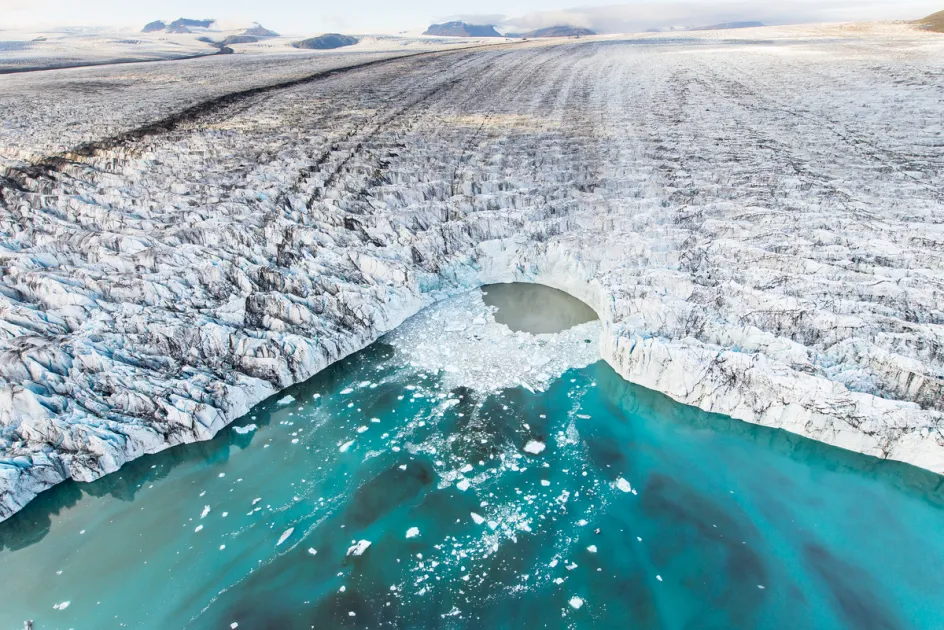Why Iceland Is Becoming A Glacier Graveyard
I cover climate change and energy through reportages, articles, interviews and in-depth reports. I am interested in the impacts of global warming on everyday life and solutions for an emission-free planet. Passionate about travel and discovery, I studied biology and other natural sciences. I have been a journalist for SWI swissinfo for more than 20 years.
-
More from this auth
Italian Departme
-
Deutsch
de
Gletscherfriedhof Island
Read more: Gletscherfriedhof Islan
Français
fr
L'Islande, de la terre de glace au cimetière des glaciers
Read more: L'Islande, de la terre de glace au cimetière des glacier
Iceland's glaciers are melting so fast that future generations may wonder how the country got its name. The northern European island nation has lost 70 of its 400 glaciersExternal link . In the past 25 years, the total area of Iceland's ice has shrunk by about a tenth while glacier thickness has dropped by an average of one metre a year, Hrafnhildur Hannesdóttir of the Icelandic Meteorological Office (IMO) tells SWI swissinfo.
“The rate of glacial mass loss is among the highest in the world,” Hannesdóttir, the national correspondent for the Swiss-based World Glacier Monitoring Service (), added via email.
As the impact of melting ice become increasingly evident, the Nordic nation is preparing for a future with fewer or even no glaciers.
The World Glacier Monitoring Service (WGMSExternal link ) collects and analyses data on the mass balance, volume, area and length of the world's glaciers. It was established in 1986 and is based at the University of Zurich. The WGMS has a network of national correspondents in more than 40 countries.
During the International Year for the Conservation of Glaciers, we contacted some of them to find out about the state of glaciers in their region, the consequences of ice melt and adaptation strategies.
A glacier graveyard in IcelandIn 2014, glaciologists had declared the Okjökull Glacier, in the centre of the country,“dead” due to human-caused climate change, the first such declaration for an Icelandic glacier.
The glacier didn't disappear completely, but it had become so thin that it was no longer being pulled by gravity down the mountainside. For the first time in tens of thousands of years, the glacier had stopped moving, a recent scientific paperExternal link explains.
Other glaciers may share the same fate. In 2024, Iceland became home to the world's first glacier graveyard, a project initiated by Rice University in Houston in the United States.
Fifteen tombstones carved into the ice near the capital Reykjavik commemorate glaciers around the world that disappeared or are endangered due to climate change. They include the Pizol glacier in eastern Switzerland, which was declared extinct in 2019.
The glacier cemetery in Iceland. Josh Okun / joklarannsoknafelag
Glaciers currently cover about 11% of Iceland's land area (in Switzerland they cover 2%). Iceland lost more glacier mass between 2000 and 2010 than in the years since, Hannesdóttir notes. The reason for this slowdown could be the influence of North Atlantic winds on the island's climate.
Nevertheless, Iceland's large glaciers such as Mýrdalsjökull, Langjökull and Vatnajökull – the largest in Europe by volume – are retreating by several hundred metres a year. If temperatures continue to rise, Iceland will be virtually ice-free in 200 yearsExternal link .
Evolution of the Hoffellsjökull glacier in Iceland from 1989 to 2020. LMÍ (left) and Kieran Baxter / islenskirjoklar (right) Glacier runoff to generate electricity
Glacier meltwater in Iceland is used to generate hydroelectric power, which accounts for about 73% of the electricity produced in Iceland (the rest comes from geothermal energy). Since the amount of water flowing from glaciers is expected to increase due to global warming, Iceland will likely expand its hydroelectric power output in the coming decades.
After that, however, the water running off glaciers will slow down. Iceland is expected to reach“peak water” – when meltwater runoff from glaciers is at its maximum level – in 40 to 50 yearsExternal link . In the Swiss Alps, the peak has already been reached in some regions and will be reached in others in the next few years.
How much Iceland's glacier meltwater increases in the coming years will depend on the climate in the North Atlantic. That includes the so-called cold blob, an area of the ocean where the air has cooled instead of warmed like the rest of the planet, says Hannesdóttir.
>> Swiss glaciers are also melting faster and faster. The following article shows the possible domestic and international consequences:
More More The international consequences of a glacier-free SwitzerlandThis content was published on Apr 7, 2025 Switzerland's glaciers could almost disappear due to global warming. Melting ice in the Alps will have an impact on large rivers in Western Europe – but it won't stop there.
Read more: The international consequences of a glacier-free Switzerlan
Legal Disclaimer:
MENAFN provides the
information “as is” without warranty of any kind. We do not accept
any responsibility or liability for the accuracy, content, images,
videos, licenses, completeness, legality, or reliability of the information
contained in this article. If you have any complaints or copyright
issues related to this article, kindly contact the provider above.
Most popular stories
Market Research

- Poppy Seed Market Size, Share, In-Depth Insights, Opportunity And Forecast 2025-2033
- Daytrading Publishes New Study On The Dangers Of AI Tools Used By Traders
- Origin Summit Debuts In Seoul During KBW As Flagship Gathering On IP, AI, And The Next Era Of Blockchain-Enabled Real-World Assets
- Chicago Clearing Corporation And Taxtec Announce Strategic Partnership
- Bitmex And Tradingview Announce Trading Campaign, Offering 100,000 USDT In Rewards And More
- ROVR Releases Open Dataset To Power The Future Of Spatial AI, Robotics, And Autonomous Systems






















Comments
No comment